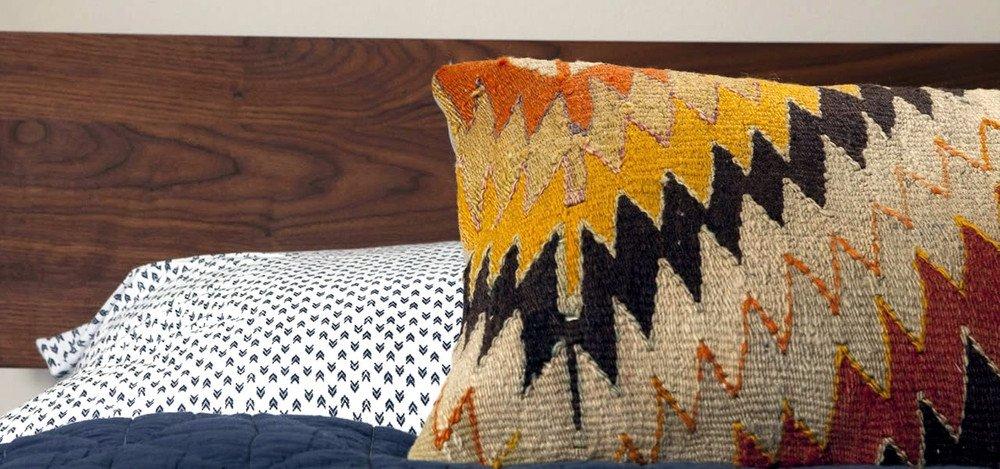Last Updated on July 18, 2023
The importance of keeping kilim pillows clean cannot be overstated. With their intricate designs and vibrant colors, Kilim pillows add a touch of elegance to any room. However, they also require special cleaning techniques to ensure longevity and beauty. Regular vacuuming is the first step in maintaining kilim pillows, as it helps remove dust and dirt that can accumulate over time. For stubborn stains, spot cleaning with a mild detergent is recommended. Properly drying and airing out kilim pillows is crucial to prevent mold and mildew growth. Lastly, following simple tips can help prevent future stains on kilim pillows. You can enjoy clean and fresh kilim pillows for years by taking these steps.
Why do kilim pillows require special cleaning techniques
- Kilim pillows are made from delicate materials that traditional cleaning methods can easily damage
- The intricate patterns and designs on kilim pillows can be quickly faded or distort if not cleaned properly
- Kilim pillows often have natural dyes that can bleed or run if exposed to harsh cleaning agents
- The unique weaving technique used to create kilim pillows can make them more prone to collecting dust and dirt
- Regular cleaning methods, such as machine washing or dry cleaning, may not be suitable for kilim pillows
Given the unique characteristics of kilim pillows, it is essential to use specific cleaning techniques to ensure their longevity and beauty.
A step-by-step guide to cleaning kilim pillows
Cleaning kilim pillows requires special techniques to ensure their longevity and maintain their vibrant colors. Follow this step-by-step guide to keep your kilim pillows looking clean and fresh for years.
First Step: Vacuuming the kilim pillows
Before you begin cleaning, it is essential to start with the first step: vacuuming the kilim pillows. This step is crucial in removing any loose dirt, dust, or debris that may be trapped in the fibers of the pads. By vacuuming the cushions, you are ensuring that the cleaning process will be more effective and efficient.
To vacuum the kilim pillows, start by attaching the upholstery attachment to your vacuum cleaner. This attachment is specifically designed for cleaning delicate fabrics like kilim. Gently run the extension over the surface of the pillows, making sure to cover all areas. Pay special attention to any crevices or folds where dirt may be trapped.
It is recommended to vacuum the kilim pillows at least once a month to maintain their cleanliness and prolong their lifespan. Regular vacuuming will prevent dirt and dust from settling deep into the fibers, making future cleaning more accessible and practical.
Second Step: Removing stains from kilim pillows
- Stains on kilim pillows can be unsightly and difficult to remove, but with the proper techniques, they can be eliminated.
- Acting quickly when a stain occurs is essential to prevent it from setting into the fabric.
- Here are some steps to follow for removing stains from kilim pillows:
- Identify the type of stain: Different colors require different cleaning methods, so knowing what you are dealing with is essential.
- Blot the stain: Use a clean cloth or paper towel to blot the stain gently. Avoid rubbing, as this can spread the color and damage the fabric.
- Treat the stain: Depending on the type of stain, you may need to use a specific stain remover or cleaning solution. Follow the instructions on the product and test it on a small, inconspicuous area of the pillow first.
- Gently scrub the stain: Using a soft brush or sponge, gently clean the paint in a circular motion. Be careful not to wash too hard, which can damage the fabric.
- Rinse the area: After treating the stain, rinse the area with clean water to remove any residue from the cleaning solution.
- Dry the pillow: Allow it to air dry completely before using it again. Avoid using heat or direct sunlight, which can cause the colors to fade.
Third step: Spot cleaning with a mild detergent
After vacuuming the kilim pillows, the next step is to spot-clean any stains that may be present. This will help remove any dirt or grime the vacuum may have missed. Here is a step-by-step guide on how to spot clean kilim pillows:
- Identify the stain: Before applying any cleaning solution, it is essential to identify the type of stain on the kilim pillow. This will help determine the best approach for removing it.
- Prepare the cleaning solution: Mix a small amount of mild detergent with warm water. Be sure to use a detergent that is suitable for delicate fabrics.
- Test the solution: Before applying the cleaning solution to the entire stain, test it on a small, inconspicuous area of the kilim pillow to ensure it does not cause any damage or discoloration.
- Apply the solution: Gently dab the cleaning solution onto the stain using a clean cloth or sponge. Avoid rubbing the paint, as this can cause it to spread or become embedded in the fabric.
- Blot the stain: After applying the cleaning solution, blot the stain with a clean, dry cloth to absorb any excess moisture and lift the color from the fabric.
- Rinse and dry: Once the stain has been removed, rinse the area with clean water to remove any remaining detergent. Allow the kilim pillow to air dry completely before using or storing it.
Fourth Step: Drying and airing out kilim pillows
After spot-cleaning your kilim pillows, it is essential to properly dry and air them out to ensure they remain clean and fresh. Here are some steps to follow:
1. Remove excess moisture
Before drying, gently squeeze out any excess moisture from the pillows. This will help speed up the drying process.
2. Air dry in a well-ventilated area
Place the pillows in a well-ventilated area, preferably outdoors or near an open window. This will allow for proper air circulation and help prevent musty odors from developing.
3. Avoid direct sunlight
Avoid drying the kilim pillows in direct sunlight, which can cause the colors to fade. Instead, choose a shaded area where they can dry naturally.
4. Fluff and rotate
Periodically fluff and turn the pillows to ensure even drying. This will help prevent any moisture from being trapped inside.
By following these steps, you can ensure that your kilim pillows are properly dried and aired out, allowing you to enjoy their clean and fresh scent for years.
Tips for preventing future stains on kilim pillows
After cleaning your kilim pillows, it is essential to prevent future stains and keep them looking fresh for years. Here are some tips to help you with that:
1. Use pillow covers
One of the easiest ways to protect your kilim pillows from stains is by using pillow covers. These covers are a barrier between the pad and any potential spills or dirt. They are also easy to remove and wash, making it convenient to keep your places clean.
2. Avoid eating or drinking near the pillows
Accidents happen, and avoiding eating or drinking near your kilim pillows is best to prevent any spills or stains. If you must have a snack or a drink, do it away from the pads or use a tray to catch any spills.
3. Regularly clean the surrounding area
Dust and dirt can quickly transfer onto your kilim pillows, so cleaning the surrounding area regularly is essential. Vacuum the floor and any nearby furniture to minimize the amount of dirt that can come into contact with your pillows.
By following these tips, you can ensure that your kilim pillows stay clean and fresh for a long time. Remember, prevention is critical to maintaining the beauty and longevity of your cushions.
Keeping Your Kilim Pillows Clean and Fresh
By following the step-by-step guide to cleaning your kilim pillows, you can ensure they remain clean and fresh for years. The importance of keeping kilim pillows clean cannot be overstated, as they enhance the aesthetic appeal of your living space and contribute to a healthy and hygienic environment.
Vacuuming is the first crucial step in maintaining the cleanliness of your kilim pillows. Regularly removing dust and debris can prevent the accumulation of dirt and allergens.
Spot cleaning with a mild detergent is the most effective method when removing stains. This gentle approach ensures that your kilim pillows’ vibrant colors and intricate patterns remain intact.
Proper drying and maintenance are essential to prevent mold and mildew growth. By allowing your kilim pillows to air out and dry thoroughly, you can avoid unpleasant odors and prolong their lifespan.
Lastly, implementing preventive measures such as using pillow covers and avoiding eating or drinking near your kilim pillows can significantly reduce the chances of future stains.
Following these cleaning techniques and tips, you can enjoy clean and fresh kilim pillows that add beauty and comfort to your home for years.
Frequently Asked Questions
1. Why do kilim pillows require special cleaning techniques?
Kilim pillows are made from delicate materials and intricate designs, which traditional cleaning methods can easily damage. Therefore, special techniques are necessary to preserve their longevity and beauty.
2. What is the first step in cleaning kilim pillows?
The first step in cleaning kilim pillows is to vacuum them. This helps remove any loose dirt, dust, or debris that may have accumulated on the surface.
3. How can I remove stains from kilim pillows?
The second step involves spot cleaning with a mild detergent to remove stains from kilim pillows. This helps break down the color without causing any damage to the fabric.
4. How should I dry and air out kilim pillows?
After cleaning, it is essential to dry and air out kilim pillows properly. This can be done by placing them in a well-ventilated area away from direct sunlight or heat sources.
5. How can I prevent future stains on kilim pillows?
To prevent future stains on kilim pillows, avoiding eating or drinking near them is recommended. Additionally, using pillow covers or protective cases can help keep them clean and free from spills.
About The Author

Tess Mack is a social media expert who has fallen down more times than she can count. But that hasn't stopped her from becoming one of the most well-known Twitter advocates in the world. She's also a web nerd and proud travel maven, and is considered to be one of the foremost experts on hipster-friendly social media. Tess loves sharing interesting facts with her followers, and believes that laughter is the best way to connect with people.

